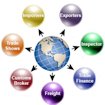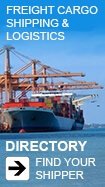This is part 4 in a series of 12 step-by-step guide to help you succeed in today's global export market.
BUSINESS PLAN
What is a Business Plan?
A business plan is a valuable management tool
that can be utilized in a wide variety of situations. In most companies,
business plans are used, among other things, for the following purposes:
- to set the goals and objectives for the company's performance
- to provide a basis for evaluating and controlling the company's
performance
- to communicate a company's message to middle managers, outside
directors, suppliers, lenders, and potential
investors.
Benefits of Having a Business PlanA business plan is the blueprint
for your company's success. It is a strategic document for you, for potential
financial backers, and for individuals who work with and/or for you. It guides
your allocation of time, money and energy while helping you to keep sight of
your objectives.
The business plan is essential to support your company's request for
financing. A well-prepared plan clarifies your business and its operations for
investors.
Your Business Plan must clearly and concisely state the following:
- Your primary objectives
- Financial projections
- Cash flow forecasts
- Profit and loss statements (if applicable)
- A statement of personal assets and liabilities.
From the start, the business plan should be viewed and written as a
management tool. For example, objectives in the plan should be compared with
actual results as a measure of the success of different strategies. It is
modified regularly as new information and experiences are gained.
A business plan provides management with a written document keeping your
company on track. By adhering to the plan, management is likely to make
business decisions that are appropriate and consistent with the established
goals of the company. The business plan should be produced with the assistance
of outside advisers such as lawyers, accountants and business mentors who can
all play important roles in guiding your plans for expansion into new world
markets.
Essential Elements of the Business Plan
The following outline can be used to build your business plan. You may wish
to cut and paste the contents into your word processor to start building your
plan today.
EXECUTIVE SUMMARY
The Executive Summary provides the reader with a clear overview of the
business plan. It should be no more than 2 pages in length. The content of the
Executive Summary should provide an outline of the highlights and present the
specific issues to be addressed in the Business Plan.
BUSINESS PROFILE
The Business Profile details the following administrative information about
the business:
Who are the owners of the business?
- Names of the partners (if applicable)
- Names of limited partners and the extent of their liability
- Names of shareholders and the percentage of shares owned (for
corporations)
What is the address and telephone number?
- Business Name
- Street Address
- Mailing Address (if different from street address)
- Telephone Number
- Fax number
- E-mail address
- Web site address
- Key company contacts and their titles
What is the legal structure of your firm?
- Legal name of the company
- Legal structure of the business (e.g., proprietorship, partnership,
corporation)
- Date of registration or incorporation
- Type of incorporation (federal or provincial)
What is the business sector and what are the main services
offered?
- The basic business sector
- The main services offered
What is the present status of the business?
- Summarize achievements and performance (financial, sales, technical
etc.) to date.
- Introduce the stakeholders in the business.
What are the R&D and technology requirements of the business,
if relevant?
- Explain progress, plans, resources.
- Highlight any technological advances.
Additional Components
Introduction
- Introduce the plan. Who wrote it, when and for what purpose?
Company Summary
- Clearly written as a one page synopsis
- Company aims and objectives
- Future company plans
Mission, Strategies, etc.
- What are the central purposes and activities of the planned business?
- What are its strengths, weaknesses, opportunities, and threats (SWOT)?
- What are its major objectives, key strategies and prime goals ?
MANAGEMENT
This section examines the competency and reliability of management:
What is their education and experience?
- Names of the key management personnel
- Education and experience of management
What are their proven management abilities?
- Background, responsibilities and qualifications of key personnel
- Steps that will be taken to offset major management deficiencies
What is the credit worthiness of the principals?
- Includes statements of personal net worth for the owners and financial
statements for other businesses which should be referred to and included in
the Appendices section.
What is the organizational structure?
- Introduce the management team, structure, etc.
MARKETING
This section outlines information that will help to build your marketing
strategy and support your sales projections. It also forms the basis for your
International Marketing Plan as outlined in Section 7 "Creating an Marketing
Plan".
What is the nature of the industry?
- A summary of market size, segments, growth trends, changes, competitors
and a user/customer profile.
- A profile of new developments, new markets and customers, new
requirements, new entrants and exits.
Who are the target customers?
- A detailed description of your target customer, such as customer needs,
buying habits and expectations regarding price, quality and service.
Who are the main competitors?
- An evaluation of the strengths and weaknesses of major competitors
- An outline of your company's competitive advantage
What is the company's marketing strategy?
- Outline the strategy you will use to get and keep your share of the
market.
What is the company's marketing plan?
Part of the business plan, the marketing plan details the role of marketing
in achieving your company's overall strategic objectives, and includes the
following:
- What services does your company plan to market? Why are they unique?
What sets your company's services apart from the competition?
- How do you price your services? Do trade terms affect the cost?
- Does the price compare with the competition's? If it is higher, why is
it more expensive? If it is lower, what are the reasons?
- Where will your company market its service?
- Which segment of the market will your company focus on?
- Is your target segment large enough to make your business worthwhile?
- Does your marketing material reflect the professionalism of your
company?
- Should you budget for media advertising and a public relations campaign?
- Where are the potential clients? How will you reach them?
- What are the fundamental elements linking your company's clients?
EXPORTING
This section describes the export strategy and other information related to
exporting. It also forms the basis for your Export Plan as covered in Module 5
"Planning Your Export Strategy".
What is your company's export strategy?
- Export objectives and approach
International market
opportunity/opportunities?
- Services your company will sell internationally
- International markets your company will service
What are your company's exporting strengths?
- Exporting experience
- Awareness, profile and credibility in export markets
- Effective networks in export markets
Resources needed to export.
- Financial Resources
- Human Resources
Export risk management and the export process?
- Professional liability Insurance
- Travel insurance
- Foreign exchange exposure
- Ensuring payment
- Creating milestones and setting time lines
OPERATIONSThis section outlines information supporting your company's
ability to provide service in the quantity or quality indicated in the
marketing plan:
What competitive advantages does the location offer?
- A description of advantages/disadvantages of the location as it relates
to staff, proximity to customer, provincial and local taxes and laws
What facilities and equipment are used?
- A description of the size and nature of the present and/or proposed
facilities and equipment including office space, computer equipment,
communications lines and access to the Internet
What is the cost of staff?
LOGISTICSThis component of the Business Plan addresses service
delivery issues:
How will your company deliver services?
- A method of how you will deliver your services to the target customer
(electronic transfer, replication, etc)
What adaptations are required to deliver service to international
markets, if any?
- International presence (i.e. agent, international executive, etc)
- Cultural adaptations
HUMAN RESOURCES
This section details the human resource requirements of the company:
What positions will be required?
- International Executive
- Project Managers
- Support Staff
What will be the job functions?
- Personnel requirements and responsibilities
Who will staff these?
- Present and/or new personnel
- Personnel with international education and experience
How skilled and experienced is the work force?
- A description of the types and availability of staff required
- An outline of special training requirements and specific union contracts
IMPLEMENTATION
- Explains the major decision points, time scales and actions required by
management
- Periodic operational and management review (measuring results against
plan)
FINANCIAL SUMMARYThis section provides information to assure that the
level of risk to the investor or lender is reasonable in relation to the
anticipated return and level of exposure. It also forms the basis for
information which will be covered in Module 8, "Financing and Insurance".
What are the financing requirements?
- List the various costs related to the business start-up or expansion
- Outline the sources of investment capital and/or borrowed
funds
What are the historical financial results? (applicable to the
existing business)
- Summarize historical performance of the business, including sales, costs
of providing services, gross profit, total expenses, and net profit or loss
What is the level and nature of existing debt? (applicable to
existing business)
- Name of the lender
- Amount of the original loan
- Amount of debt outstanding
- Maturity date (if applicable)
- Interest Rate
- Monthly payment
- Security
What is the projected profitability?
- An estimate of sales and expenses with a calculation of the anticipated
profit for the next twelve months
What is the break-even sales level?
- A calculation of the break-even point in dollars and units.
What are the cash flow requirements?
- A month-by-month projection for a twelve-month period, of the
anticipated cash inflows and outflows
What is the pro forma/opening balance sheet?
A copy of the pro forma balance sheet (for an existing business) or opening
balance sheet (for a new business)
What is the pro forma income statement?
- A copy of the pro forma income statement
APPENDICESThis section provides copies of detailed documents referred
to in various parts of the report. Some examples of the documents that might
be included in this section are:
Background Data on Target Countries and Market
Basic Market Statistics: Historical and Projected
Background Facts
- Company Registration/Certificate of Incorporation
- Appraisals of Realty or Capital Equipment
- Statements of Personal Net Worth
- Organizational Charts
- Equipment Lists (computers, etc..)
- Contracts
- Reference Letters
- Financial Statements
- Detailed Cash Flow Forecasts
- Asset Valuation
- Detailed Management Biographies
- Company Services Literature
- Competitive Environment
| 


